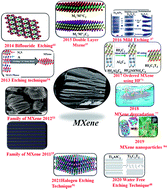New insights on MXene and its advanced hybrid materials for lithium-ion batteries†
Abstract
Electrode materials with exceptional cyclic stability and high-rate performance have been in extensive demand for the fast growth of energy storage applications. The focus of this article is on the recent progress, scientific challenges and future developments of advanced materials as anodes based on the two-dimensional (2D) MXene-based hybrid materials used in next generation lithium-ion batteries (LIBs). There is a big issue that extensively affects their performance, such as the restacking aggregation problem of MXene flakes. To address this issue, a basic and effective approach is to combine MXene with suitable and advanced materials, such as silicon, tin, different carbon nanofillers, metal oxide, phosphorous, metal sulphide and layered double oxide, to form the MXene hybrid composites. MXene surfaces have been modified in many ways, including decorating with silicon and tin-based nanoparticles, bridging networks with carbon nanofillers, and forming a heterostructure between graphene and MXene layers. The hybrid material has led to high ionic mobility, high diffusivity of Li+-ions, and electrical conductivity apart from specific capacity. In the current scenario, advanced electrode materials of LIBs should be highly promising to enhance the electrochemical performance of the batteries to make it more efficient than previously observed. The MXene-based hybrid nanostructure materials provide insight into future challenges and guidelines for finding new materials used in next-generation energy storage applications.

- This article is part of the themed collection: Sustainable Energy and Fuels Recent Review Articles


 Please wait while we load your content...
Please wait while we load your content...